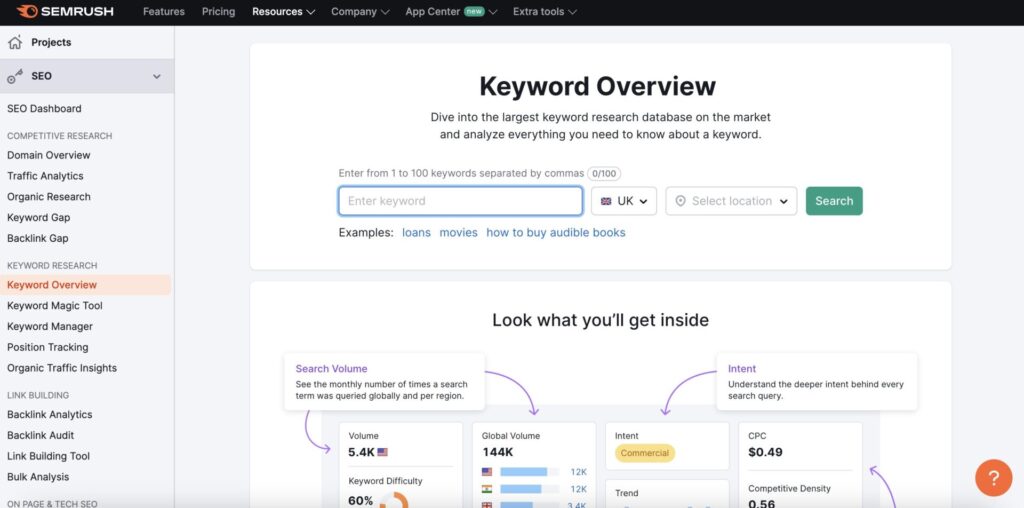Keyword research is an essential part of any successful SEO strategy. How efficiently you do it and what keyword research techniques you apply makes all the difference.
In this article, we’ll take a look at our keyword research techniques and show you how to use them to increase your website Traffic.
1. Find Seed Keywords for Your Content
Seed keywords are the starting point for any keyword research. They are the broad terms that you think best describe the products, services or information that your website offers.
Start by brainstorming a list of seed keywords and then use keyword research tools to find related keywords that you may not have thought of.
To find the best seed keywords for your blog post, consider the following:
- Use descriptive terms that accurately represent your products or services mentioned in your blog/website.
- Think about the language that your customers would use when searching for your products or services.
- Create a list of at least 10-15 seed keywords to start your research.
2. Use Keyword Research Tools
There are several keyword research tools available, both free and paid, that can help you find keywords related to your seed keywords. Some of the best include Google Keyword Planner, SEMrush, and Ahrefs.

These tools will provide you with valuable information such as the search volume, competition, and estimated cost per click for each keyword and give you the required information you need to apply your keyword research techniques.
When using keyword research tools, apply these tips:
- Look for keywords with a high search volume and low competition.
- Use the information from keyword research tools to refine your list of seed keywords and find new keywords.
- Consider using a mix of free and paid keyword research tools to get the best results.
3. Check Competitor Keywords
‘Competitors’ essentially means the websites that share the same niche and target audience as you.
One of the best ways to find new keywords is by looking at what your competitors are doing. Look at their website and see what keywords they are ranking for. You can also use tools such as SEMrush to see what keywords your competitors are ranking for and how you can improve upon their strategy.
When looking at competitor websites, consider the following:
- Use keyword research tools to analyse their website and find the keywords they are ranking for.
- Look at their content and see how they are using keywords to drive traffic to their website.
- Use the information from competitor websites to find new keywords and refine your SEO strategy.
4. Check Out Google Suggest

Google Suggest is probably the most obvious yet affective feature to help you do an efficient keyword research and give you a head-start to apply keyword research techniques. This feature shows you a list of related search terms as you type in a word or sentence in the Google search box.
This is a great way to find new keywords that you may not have thought of. Simply start typing in a seed keyword and see what Google Suggest shows you. When using Google Suggest, consider the following:
- Look for keywords with a high search volume and low competition.
- Use Google Suggest to find keywords that are relevant to your products or services.
- Consider using Google Suggest to find long-tail keywords related to your seed keywords.
5. Utilize Google Trends
Google Trends is a free tool that allows you to see what keywords are trending over time. This is useful for finding keywords that are becoming more popular and may have potential for driving traffic to your website.
You can also use Google Trends to compare different keywords and see which ones are more popular and decide which of them you want to target with your keyword research techniques. When using Google Trends, follow these simple steps:
- Look for keywords that are becoming more popular over time.
- Use Google Trends to compare different keywords and see which ones have the most potential.
- Consider using Google Trends to find keywords that are relevant to current events or seasonal trends.
6. Analyse Search Intent
When conducting keyword research, it’s important to understand the search intent behind each keyword. Search intent refers to the reason why someone is searching for a particular keyword. There are four main types of search intent:
- Navigational: people are searching for a specific website or webpage.
- Informational: people are searching for information about a specific topic.
- Transactional: people are searching with the intent to make a purchase.
- Commercial: people are researching products or services before making a purchase.
By understanding the search intent behind each keyword, you can optimise your content to better meet the needs of your audience. For example, if a keyword has a transactional intent, you should optimise your content to include information on pricing, shipping, and product specifications.
Furthermore you should try to avoid keywords with navigational search intent as the intent is to reach a specific page or website, which makes it not fruitful even if your page gets ranked on the first page. The searchers are only gonna open that specific website/page they searched for.
For example, the keyword “YouTube” is a navigational keyword that signifies that the user is most probably interested in opening YouTube.com and not any other website or page that ranks for the same keyword.
7. Consider Long Tail Keywords
Long-tail keywords are longer, more specific phrases that are less competitive and easier to rank for. For example, “best running shoes for men” is a long-tail keyword, while “running shoes” is a more general, shorter keyword. These are specially beneficial for new and beginner websites.
By targeting long-tail keywords, you can attract a more targeted audience, and increase your chances of ranking in search engines. However, researching long tail keywords can be a little tricky, but InsideAdX has got you covered with the perfect 4 step long tail keywords research tutorial.
Additionally, long-tail keywords are often more specific and can help you better understand the search intent of your audience, allowing you to create content that is tailored to their needs.
When conducting keyword research, be sure to consider both short-tail and long-tail keywords to ensure you are optimising your content for both general and specific search terms.
Bonus Tip: Don’t Neglect Local Keywords in Your Keyword Research Techniques

If your business serves a specific geographic location, make sure to include local keywords in your keyword research. Local keywords can help you rank higher in search results for people searching for products or services in your area.
Bonus: List of Keyword Research Tools (Paid & Free)
These are our picks of some of the best paid and free keyword research tools to help you apply keyword research techniques successfully.
- Google Keyword Planner (Free)
- SEMrush (Paid)
- Ahrefs (Paid)
- Moz Keyword Explorer (Paid)
- Ubersuggest (Free)
- Keyword Tool (Paid)
- SERPstat (Paid)
- Keywords Everywhere (Free)
- Keyword Tool Dominator (Free)
- Keyword Finder
Conclusion

By following the keyword research techniques outlined in this article, you can identify the best keywords for your website, and optimise your content to rank higher in search engines.
Whether you are a seasoned pro or just starting out, the key to keyword research success is to be thorough, strategic, and patient. With the right approach, tools and our proved keyword research techniques, you can find the right keywords to help your website succeed in search engines.
Recommended article: Here’s how to steal 3.6 Million traffic from your competitors.

